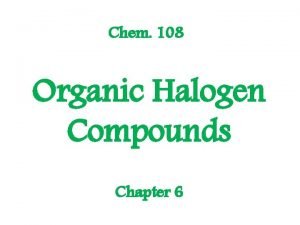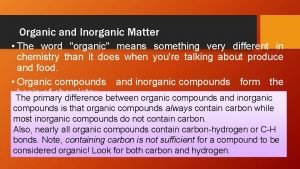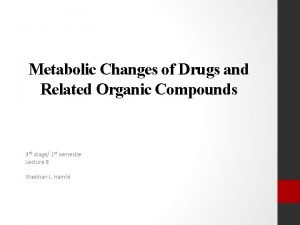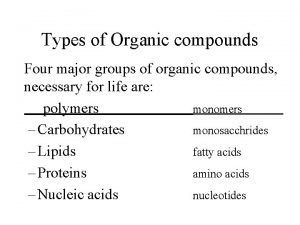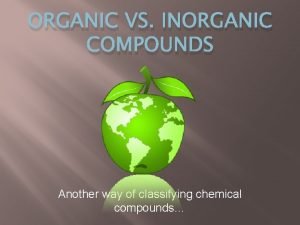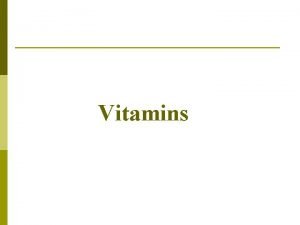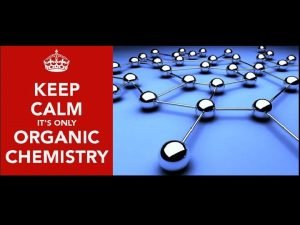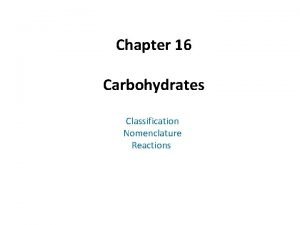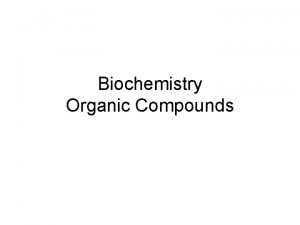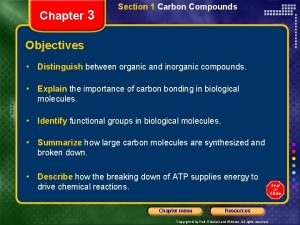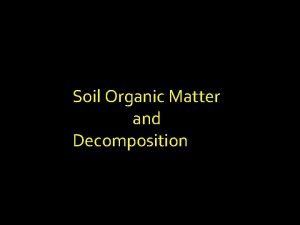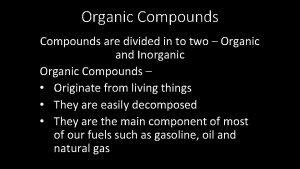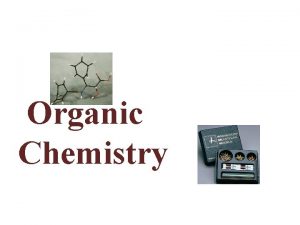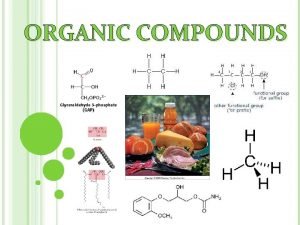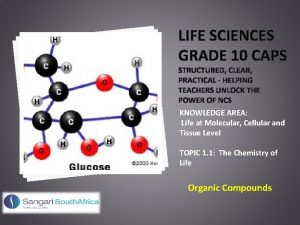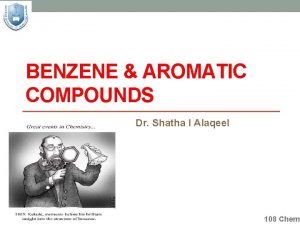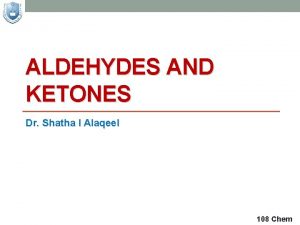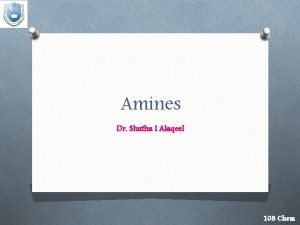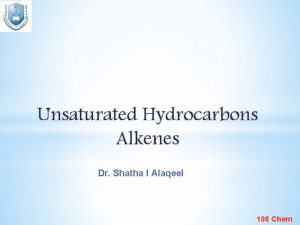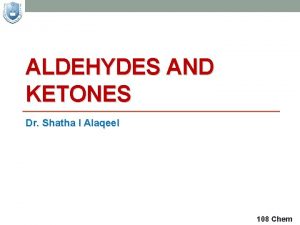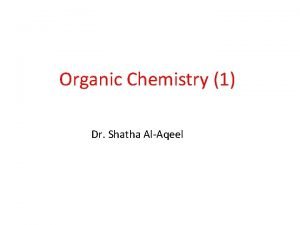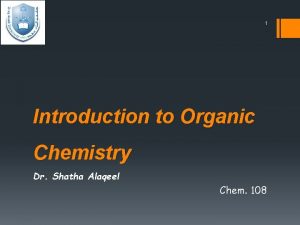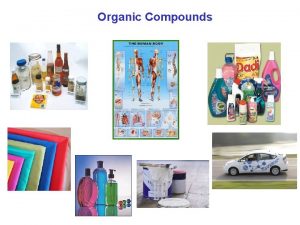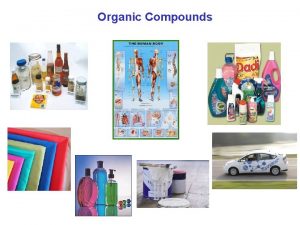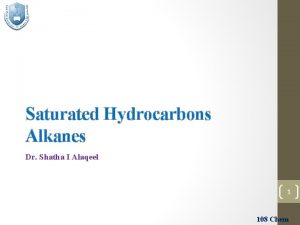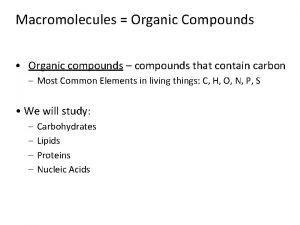Organic Halogen Compounds Dr Shatha I Alaqeel 108




















- Slides: 20

Organic Halogen Compounds Dr. Shatha I Alaqeel 108 Chem

Learning Objectives Chapter five discusses the following topics and by the end of this chapter the students will: Ø Recognize the structure and classes of alkyl halides Ø Know the common names and understand the IUPAC rules for nomenclature of halo compounds Ø Understand the physical properties of halo compounds (solubility and boiling points) Ø Know the different methods used in preparation of halo compounds Ø Know the reactions of halo compounds; nucleophilic substitution, elimination, reduction reactions of Grignard reagents and know the previously disused methods of reducing alkyl halides (Chapter-1) 2 108 Chem

Structure Of Alkyl Halides � Alkyl halides: are compounds contain the C-X bond where X is a halogen (F, Cl, Br or I) � The chemistry of Organic halogen compounds is important because these compounds are very useful intermediates for the synthesis of wide range of other substances. 3 108 Chem

Classification These may be classified as mono, di, or polyhalogen (tri-, tetra-, etc. ) compounds depending on whether they contain one, two or more halogen atoms in their structures Monohalocompounds According to hydrocarbon gp. 1 -Alkyl halides or haloalkanes( R-X) 2 -Allylic halides 3 -Vinylic halides 4 -Benzylic halides 5 -Aryl halides or haloarenes 1 -Alkyl halides or haloalkanes( R-X) has a halogen atom bonded to one of the sp 3 hybrid atoms of an alkyl group, depending on the type of carbon to which the halogen is attached Ø Primary alkyl halide 1° CH 3 -X and R-CH 2 -X Ø Secondary alkyl halide 2° (R)2 -CH-X Ø Tertiary alkyl halide 3° (R)3 -C-X 4 108 Chem

compound CH 3 -Cl (CH 3)2 -CH-F Common Methyl Chloride Isopropyl fluoride t. Butyl bromide IUPAC Chloromethane 2 -Fluoropropane 2 -Bromo-2 methylpropane Class 1° 2° 3° 2 -Vinylic halides has a halogen atom bonded to one of the sp 2 hybrid carbon atoms of an alkene (C=C) CH 2=CHBr Vinyl bromide Bromoethene 5 1 -Bromocyclohexene 108 Chem

3 -Allylic halides has a halogen atom bonded to carbon sp 3 next to a double bond carbon CH 2=CHCH 2 Cl Allyl chloride 3 -Chloro-1 -propene 3 -Bromocyclohexene 4 -Benzylic halides Ar-C-X ( has a halogen atom bonded to carbon sp 3 hybrid next to aromatic ring) Benzyl Chloride Diphenylmethyl bromide 5 -Aryl halides (haloarene) Ar-X has a halogen atom bonded to one of the sp 2 hybrid carbon atoms of an aromatic ring (X directly attached to ) Chlorobenzene 6 p-Bromo toluene 108 Chem

Polyhalogen compounds are carbon compounds containing more than one halogen atom. Many polyhalogen compounds are useful in the industry and in agriculture. 7 108 Chem

Common name OF Alkyl halides Common names derived from the corresponding alkyl group followed by the name of halogen atom. 8 108 Chem

Nomenclature OF Alkyl halides IUPAC names derived from the names of parent organic compound (alkane or alkene or alkyne or alcohol or aldehydes and so on) with a prefix indicating halogens and their positions. (Halo……) CH 3 -Cl CH 3 -CH 2 -Br (CH 3)2 -CH-F Common IUPAC Class Methyl Chloride Chloromethane 1° Ethyl bromide Bromoethane 1° Isopropyl fluoride 2 -Fluoropropane 2° Common Cyclohexyl Iodide t-Butyl bromide Methylcyclopentyl chloride IUPAC Iodocyclohexane 2 -Bromo-2 - methylpropane 1 -Chloro-1 -methyl cyclopentane Class 2° 3° 3° 9 108 Chem

PHYSICAL PROPERTIES OF ORGANIC HALIDES Solubility All organic halides are insoluble in water and soluble in common organic solvents such as CCl 4 and C 6 H 6. Ø Boiling point The boiling points increases with increasing in molecular weights. Ø Therefore, the boiling points increases in the order F < Cl < Br < I. (the size (molecular wt) of the halogen increase ) Ø Alkyl halides have higher melting points than alkanes, alkenes, alkynes because of : 1. Polarity 2. Molecular weight Ø 10 108 Chem

Nature of (C-X) Bond Halogen atoms are more electronegative than carbon. C-X bond of alkyl halide is polarized: The carbon atom bears a partial positive charge whereas the halogen atom bears a partial negative charge. 11 108 Chem

Preparation Of Halocompounds 1 - Direct Halogenation Of Hydrocarbons a) Halogenation of alkanes b) Halogenation of alkenes 12 108 Chem

c) Halogenation of alkynes d) Halogenation of alkyl benzene 13 108 Chem

2 - Conversion Of Alcohols The hydroxyl group of an alcohol is replaced by halogen 14 108 Chem

Reactions of Organic Halides 1 - Nucleophilic Subtitution Reactions SN δ+ δ- Nu- = -OH, -OR, -OCOR, -SH, -SR, -CN, 15 108 Chem

16

2 - Elimination Reactions (E) Alkyl halides can lose HX molecule to give an alkene. Ø If the haloalkane is unsymmetrical (e. g. 2 -bromobutane or 2 -bromopentane) a mixture of isomeric alkene products is obtained. Ø 17 108 Chem

3 - Reaction of Grignared reagent a- Formation of Grignard reagent b- Reaction of Grignard reagent 18 108 Chem

4 - Reduction of alkyl halides a) By metal and acid or by metal hydrides b) By sodium metal (Coupling reaction)(Wurtz reaction) c) By lithium dialkyl cuprate (Symmetrical and non symmetricalalkane) 19 108 Chem

Thank You for your kind attention ! Questions 20 108 Chem
 Organic halogen compounds
Organic halogen compounds Solve for f fva=(c((1 0.108/12)^120-1))/(0.108/12)
Solve for f fva=(c((1 0.108/12)^120-1))/(0.108/12) Obtuse
Obtuse Nomenclature of alkanes
Nomenclature of alkanes Organic versus inorganic compounds
Organic versus inorganic compounds Metabolic changes of drugs and related organic compounds
Metabolic changes of drugs and related organic compounds Four types of organic compound
Four types of organic compound Organic vs inorganic compounds
Organic vs inorganic compounds Organic compound made by living things
Organic compound made by living things Vitamins are organic compounds that
Vitamins are organic compounds that Type of organic compounds
Type of organic compounds Reactions of organic compounds
Reactions of organic compounds What is organic chemistry
What is organic chemistry Four types of organic molecules
Four types of organic molecules All organic compounds contain carbon and ________.
All organic compounds contain carbon and ________. Decomposition of organic compounds
Decomposition of organic compounds What is the classification of organic compounds
What is the classification of organic compounds Classification of organic compounds
Classification of organic compounds All organic compounds must contain the element
All organic compounds must contain the element Organic compounds
Organic compounds Organic compounds grade 10 life science
Organic compounds grade 10 life science
